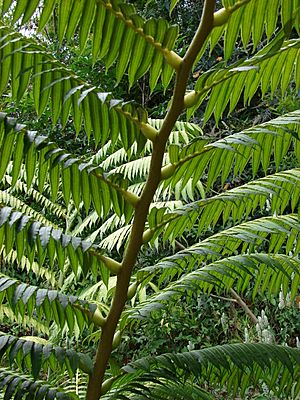Marattiaceae facts for kids
Quick facts for kids Marattiaceae |
|
|---|---|
 |
|
| Angiopteris evecta frond | |
| Scientific classification |
|
| Kingdom: | Plantae |
| Clade: | Tracheophytes |
| Class: | Polypodiopsida |
| Subclass: | Marattiidae Klinge |
| Order: | Marattiales Link |
| Family: | Marattiaceae Kaulf. |
| Genera | |
Marattiaceae is a special family of ferns. They are the only living members of a group called Marattiales. This family includes six different types of ferns, called genera, and about 110 species. Many Marattiaceae ferns look quite different from other ferns you might know. They often have very large leaves, called fronds, and thick, fleshy roots.
Contents
What Makes Marattiaceae Ferns Unique?
Marattiaceae ferns are very old. They branched off from other ferns early in their history. This means they look different from many ferns found in cooler parts of the world. Many of these ferns have huge, thick roots. They also have the largest fronds of any fern known!
These ferns have a special way of making their spores. Their spore cases, called sporangia, grow from a group of cells. This is different from most other ferns.
Meet Some Marattiaceae Ferns
Let's look at some of the interesting ferns in this family:
The Giant Angiopteris Ferns
The Angiopteris genus is known for its huge fronds. These ferns grow naturally in places like Australasia, Madagascar, and Oceania. One species, Angiopteris teysmanniana, found in Java, can have fronds up to 9 meters (about 30 feet) long! That's like the length of a small bus!
In Jamaica, a species called Angiopteris evecta grows widely. It was brought there by Captain William Bligh from Tahiti in 1860. It was used as a food source for people working on plantations. From the Castleton Botanical Garden, it spread across the eastern part of the island. It is now considered an invasive species because it can take over areas.
Marattia and Eupodium Ferns
The Marattia ferns are found in the Americas and Hawaii. Another genus, Eupodium, also grows in the Americas. It has three species. Eupodium ferns have fronds that are divided many times. They usually grow only one or sometimes two fronds each year.
Ptisana Ferns: The King Fern
Ptisana is a genus found in warmer parts of the world, like Africa and Asia. These ferns also have large fronds, similar to Angiopteris.
The king fern, Ptisana salicina, is a famous member of this group. It comes from New Zealand and the South Pacific. In the Māori language, it's called "para." This large fern has a thick, edible root that some native peoples use as food. It's sometimes called the potato fern.
The Unique Christensenia Fern
The Christensenia genus is found in East Asia. It's named after a Danish fern expert, Carl Christensen. These ferns are uncommon and have very unique fronds. They look a bit like the leaves of a horse chestnut tree. That's why one species is called Christensenia aesculifolia. Even though these ferns are small, they have the largest pores (called stomata) on their leaves of any plant!
Danaea Ferns
The Danaea genus is found only in the Americas. These ferns have leaves divided into many leaflets. Their fertile leaves, which carry the spores, look different from their regular leaves. They are covered underneath with sunken spore cases.
How Marattiaceae Ferns are Classified
In the way scientists classify plants today (called the Pteridophyte Phylogeny Group classification of 2016, or PPG I), Marattiaceae is the only family in its order, Marattiales. This order is also the only one in its subclass, Marattiidae.
Marattiidae is one of four main groups of ferns. It is closely related to the group that includes most other ferns you see. Here's a simple diagram showing how ferns are related:
| Polypodiopsida (All Ferns) |
|
||||||||||||||||||
History of Classification
For a long time, scientists recognized four main living groups (genera) of Marattiaceae: Angiopteris, Christensenia, Danaea, and Marattia. However, newer studies using genetics showed that the Marattia group needed to be split. So, two new genera were created: Eupodium and Ptisana. This means there are now six accepted genera in the Marattiaceae family.
This fern group has a very long history. Many types of Marattiaceae ferns are only known from fossils. These ancient ferns lived millions of years ago.
Genera of Marattiaceae
Here are the six genera (groups) of Marattiaceae ferns that scientists recognize today:
- Angiopteris
- Christensenia
- Danaea
- Eupodium
- Marattia
- Ptisana
Some other names have been used for ferns in this family in the past. However, these are now considered to be the same as Angiopteris.
Evolutionary History
Marattiaceae ferns are thought to be some of the most ancient living ferns. The first members of this family appeared over 300 million years ago, during a time called the Carboniferous period. We have found many fossils of these ferns from the Carboniferous up to the Jurassic period. This shows they have been around for a very, very long time!
See also
 In Spanish: Maratiáceas para niños
In Spanish: Maratiáceas para niños

